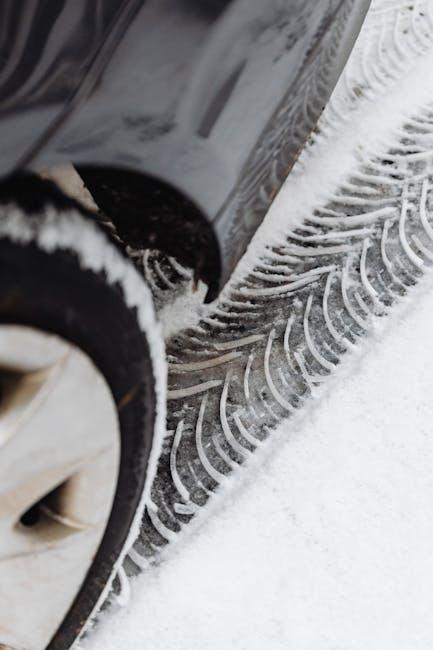Imagine driving down a quiet highway when suddenly, you feel the unmistakable thud of a punctured tire. Traditionally, this would mean an inconvenient and sometimes dangerous roadside pit stop, followed by a slow crawl to the nearest repair shop. Enter run-flat tires — a modern innovation promising to keep you moving even after a puncture. But like any technology, run-flat tires come with their own set of advantages and drawbacks. In this article, we’ll take a balanced look at the pros and cons of run-flat tires, helping you decide if they’re the right fit for your vehicle and lifestyle.
Table of Contents
- Understanding How Run-Flat Tires Work in Modern Vehicles
- Advantages of Run-Flat Tires for Safety and Convenience
- Common Drawbacks and Limitations of Run-Flat Technology
- Impact of Run-Flat Tires on Vehicle Performance and Ride Comfort
- Maintenance Tips and What to Expect with Run-Flat Tires
- Choosing Between Run-Flat Tires and Traditional Options for Your Driving Needs
- Q&A
- Key Takeaways

Understanding How Run-Flat Tires Work in Modern Vehicles
Run-flat tires are engineered with reinforced sidewalls that allow them to support the vehicle’s weight even after a loss of air pressure. This innovation means drivers can continue to travel for a limited distance—typically around 50 miles at a reduced speed—after puncture or deflation, without immediately needing to change the tire on the roadside. The unique construction prevents the tire from collapsing, providing a safer and more convenient alternative to traditional tires. Many modern vehicles equipped with run-flat tires also incorporate tire pressure monitoring systems (TPMS), alerting drivers promptly in case of a pressure drop.
Key features of run-flat tires include:
- Enhanced sidewall strength to maintain structure after puncture
- Compatibility with TPMS for real-time monitoring
- Ability to drive on a flat tire for emergency situations
- Improved safety by reducing the risk of losing vehicle control
| Aspect | Run-Flat Tires | Traditional Tires |
|---|---|---|
| Sidewall Strength | Reinforced | Standard |
| Travel Distance After Deflation | Up to 50 miles | Immediate stop needed |
| Compatibility | Requires TPMS | Not necessary |
| Weight | Heavier | Lighter |

Advantages of Run-Flat Tires for Safety and Convenience
Run-flat tires revolutionize the way drivers handle unexpected tire punctures by allowing the vehicle to continue moving safely without immediate replacement. Their reinforced sidewalls support the vehicle’s weight even when air pressure drops, preventing sudden blowouts and giving drivers the confidence to reach a safe location. This not only minimizes roadside emergencies but also reduces the stress associated with being stranded on busy roads or in remote areas.
Beyond safety, these tires offer unparalleled convenience. With run-flat technology, there’s no need to carry a bulky spare tire or rush to find the nearest service station. This can be especially beneficial during night drives or in adverse weather conditions. Additionally, the ability to maintain mobility for up to 50 miles at reduced speeds means drivers can plan tire replacements on their schedule, rather than reacting to immediate danger.
- Enhanced control during sudden tire pressure loss
- Added peace of mind on long or isolated trips
- Elimination of immediate roadside tire changes
- Space-saving by removing the need for spare tires
- Improved overall vehicle safety in emergency situations
| Feature | Benefit | Impact |
|---|---|---|
| Reinforced Sidewalls | Supports vehicle weight without air pressure | Prevents immediate loss of control |
| Extended Mobility | Drive up to 50 miles after puncture | Allows safe arrival at repair shop |
| No Spare Needed | Frees up trunk space | Improves cargo capacity |

Common Drawbacks and Limitations of Run-Flat Technology
While the appeal of run-flat tires lies in their ability to maintain mobility after a puncture, it’s important to weigh these benefits against their notable limitations. One significant drawback is their stiffer ride quality, which can feel less comfortable compared to conventional tires due to reinforced sidewalls designed to support the vehicle’s weight when air is lost. Additionally, these tires often come with a higher upfront cost and can be more expensive to replace or repair, impacting the overall cost-efficiency for many drivers.
Furthermore, run-flat tires are limited in availability and versatility. They may not be compatible with all vehicles or wheel types, restricting consumer choice. Their design also means that once they reach their post-puncture mileage limit—usually around 50 miles at a reduced speed—the tire must be replaced rather than repaired. Here’s a quick summary of these constraints for easy reference:
| Drawback | Details |
|---|---|
| Ride Comfort | Stiffer sidewalls reduce shock absorption |
| Cost | Typically more expensive to buy and replace |
| Repairability | Often must be replaced rather than repaired after run-flat use |
| Compatibility | Limited fitment across some vehicle models and wheel types |

Impact of Run-Flat Tires on Vehicle Performance and Ride Comfort
Run-flat tires are engineered to keep a vehicle mobile even after a puncture, but this innovation brings a nuanced shift in overall driving dynamics. One immediate effect is an increase in tire stiffness, which enhances cornering stability and control during emergency maneuvers. This structural robustness allows the tire to maintain its shape without air pressure, providing drivers with a precious margin of safety. However, the firmer sidewalls often translate into a less forgiving ride, sometimes making surface imperfections and bumps more noticeable compared to conventional tires.
When it comes to ride comfort, there’s a delicate balance between safety and smoothness. The specialized technology and reinforced design can add weight and reduce the tire’s ability to absorb shocks, which may lead to a harsher ride experience, especially on uneven or rough roads. Drivers might also notice increased road noise, but these factors vary depending on the tire brand and vehicle setup. Below is a quick comparison summarizing the key impacts:
| Aspect | Run-Flat Tires | Conventional Tires |
|---|---|---|
| Safety | Allows driving after puncture | Immediate stop required |
| Ride Comfort | Firmer, less cushioning | Softer, more cushioning |
| Noise Levels | Generally higher road noise | Lower road noise |
| Handling | Improved stability | Normal stability |

Maintenance Tips and What to Expect with Run-Flat Tires
When it comes to caring for run-flat tires, vigilance is key. Unlike traditional tires, run-flats are designed with reinforced sidewalls that can temporarily support the vehicle’s weight after a puncture. This unique construction means you should:
- Check tire pressure regularly—ideally once a month—since run-flats often have built-in pressure sensors but no spare tire backup.
- Be mindful of ride comfort; over time, run-flats may feel stiffer, signaling it could be time for a professional inspection.
- Avoid prolonged driving after a puncture even though the tire can handle limited distance; typically, you have about 50 miles at reduced speeds to seek repairs or replacements.
Expect some differences in maintenance routines compared to standard tires. For instance, run-flats often require specialized equipment for mounting and balancing. Additionally, if a run-flat has been driven flat—even briefly—it’s generally advised to replace the tire rather than repair it. To help clarify, here’s a simple comparison of key maintenance expectations:
| Aspect | Run-Flat Tires | Standard Tires |
|---|---|---|
| Pressure Monitoring | Mandatory & built-in sensors | Recommended, manual or external gauges |
| Post-Puncture Use | Up to 50 miles at reduced speed | Must replace or repair immediately |
| Repair Viability | Rarely recommended | Commonly repairable |
| Installation | Requires specialist tools | Standard tire equipment |

Choosing Between Run-Flat Tires and Traditional Options for Your Driving Needs
When deciding between run-flat tires and traditional options, it’s essential to weigh the specific benefits against your driving habits and needs. Run-flat tires provide the convenience of continuing your journey even after a puncture, typically allowing you to travel up to 50 miles at reduced speeds without immediate repair. This feature is ideal for drivers who prioritize safety and convenience, especially those who often find themselves driving in remote areas or heavy traffic. However, run-flats tend to be stiffer and may slightly affect ride comfort and handling dynamics compared to traditional tires. Additionally, they generally come with a higher price tag and can be less widely available at local repair shops, which might be a key consideration for budget-conscious drivers.
Traditional tires maintain their place as a popular choice due to their variable performance options and generally lower replacement costs. They often deliver a smoother and quieter ride, giving enthusiasts and everyday drivers alike a more comfortable and sometimes sportier feel. However, the main drawback of traditional tires is their dependence on having a readily accessible spare tire or roadside assistance in the event of a flat. Here’s a quick comparison to help visualize the trade-offs:
| Aspect | Run-Flat Tires | Traditional Tires |
|---|---|---|
| Flat Tire Management | Can drive up to 50 miles without air | Requires immediate repair or spare tire |
| Ride Comfort | Generally firmer, possibly less smooth | Smoother, more flexible options available |
| Cost | Higher initial and replacement cost | More affordable and widely available |
| Availability | More limited, especially in remote areas | Common and easy to find everywhere |
- Choose run-flats if safety and staying mobile after a puncture are paramount.
- Opt for traditional tires if comfort, price, and flexibility in repair options drive your decision.
Q&A
Q: What exactly are run-flat tires?
A: Run-flat tires are specially engineered tires designed to keep rolling safely for a limited distance even after losing air pressure. This means you can continue driving without an immediate tire change, typically up to 50 miles at reduced speeds.
Q: How do run-flat tires manage to drive without air?
A: They have reinforced sidewalls or internal supports that resist collapsing when the tire loses air, allowing the tire to maintain its shape and support the vehicle’s weight temporarily.
Q: What are the primary advantages of run-flat tires?
A: Convenience tops the list—no urgent roadside tire changes in unsafe or inconvenient locations. They also let you maintain steering control and avoid sudden blowouts, enhancing safety. Plus, some car makers appreciate the space savings since no spare tire is needed, freeing up trunk space.
Q: Are there any downsides to using run-flat tires?
A: Yes, they tend to be more expensive upfront and can cause a firmer ride due to their stiffer sidewalls. Replacement options might be limited, and some users report reduced tread life. Also, if a run-flat tire runs completely flat and is driven too long, it can’t be repaired as easily as conventional tires.
Q: Can I use run-flat tires on any vehicle?
A: Technically yes, but they’re most effective on vehicles equipped with tire pressure monitoring systems (TPMS) since it’s harder to detect a slow leak by feel. They’re commonly found on luxury and performance cars where safety and convenience are priorities.
Q: How do run-flat tires affect fuel economy?
A: There might be a slight decrease in fuel efficiency because run-flat tires can be heavier and have higher rolling resistance. However, the difference is usually minimal and varies based on the tire model and driving conditions.
Q: Should I switch to run-flat tires?
A: It depends on your priorities. If peace of mind and safety in case of a puncture are paramount—and you don’t mind a firmer ride and higher cost—they’re a great option. But if you value a smooth ride and lower replacement costs, conventional tires might suit you better.
Q: What happens if I ignore a flat on a run-flat tire and keep driving?
A: While run-flats are built to endure brief deflation, driving extensively without air pressure will damage the sidewalls and make the tire irreparable. It’s best to stop and have the tire inspected or replaced as soon as symptoms arise.
Q: Can run-flat tires be repaired after a puncture?
A: Typically, minor punctures within the tread area can be repaired, but damage to the sidewall or extended driving on a flat usually means the tire needs replacement. Always consult a professional for evaluation.
Q: How do run-flat tires impact the driving experience?
A: Expect a firmer and sometimes noisier ride due to stiffer construction. Handling may feel slightly different, often more precise but less forgiving on rough roads. Your vehicle’s suspension may need to be calibrated for the specific tires.
Key Takeaways
In the fast-evolving world of automotive technology, run-flat tires represent a bold step toward convenience and safety. Their promise of keeping you moving after a puncture can be a game-changer on the road, offering peace of mind when you might otherwise be stranded. Yet, like any innovation, they come with trade-offs—whether in cost, ride comfort, or tire life. Choosing run-flat tires ultimately boils down to your personal priorities and driving habits. By weighing their advantages against the limitations, you can decide if these resilient tires are the right fit for your journey ahead. After all, in the quest for safer roads, it’s not just about how you drive—but how your tires keep up.

